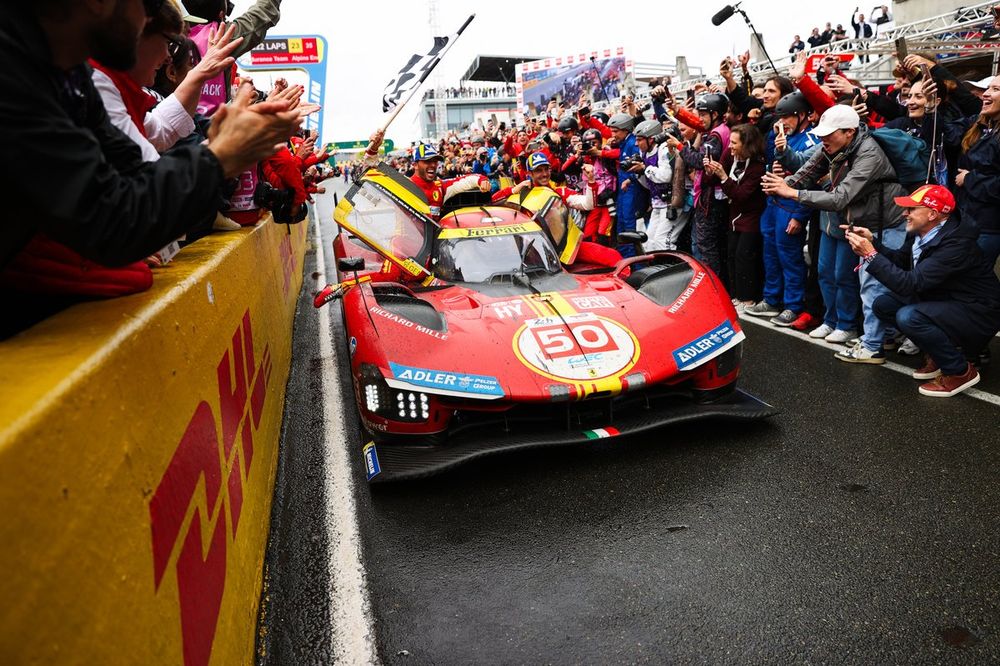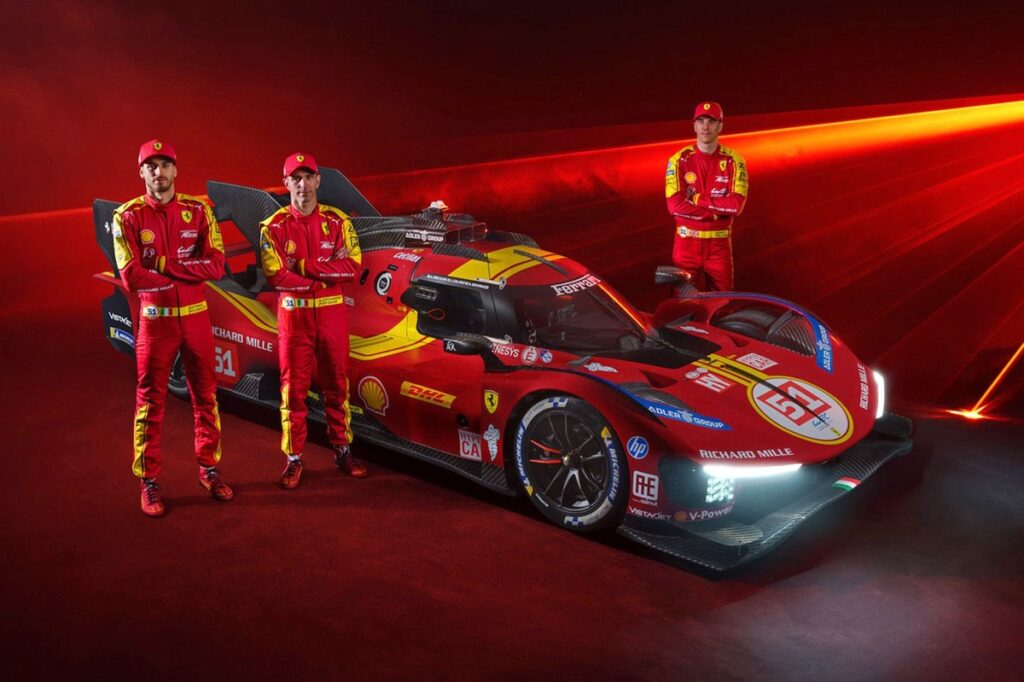Win the championship or keep the trophy? Offer Ferrari the choice of claiming a title in the World Endurance Championship this year or taking ownership of the latest piece of silverware given to the victor of the Le Mans 24 Hours by making it three in a row, and a range of answers are forthcoming. You get the impression, however, that the trinkets on offer at the end of the season, the ones for the drivers’ and manufacturers’ titles, are what the Italian manufacturer really wants.
Antonello Coletta, Ferrari’s long-time boss of sportscar racing, waivers, as well as he might. He wants both, but, he says, “now the most important goal of the season is the world championship” and says he doesn’t understand why “many people speak about only Le Mans and not about the championship”. Coletta doesn’t distinguish between the Hypercar class drivers’ and the manufacturers’ titles. He’s probably not fussy.
James Calado, who along with Antonio Giovinazzi and Alessandro Pier Guidi took Ferrari’s on-debut comeback win with a factory prototype at Le Mans in 2023, is unequivocal. He makes no secret of his desire to become world champion. Or rather world champion again. He already has three crowns in GTE Pro with Ferrari, and they were all pukka FIA world titles – it may be semantics but GTE Pro went from cup to championship status the year before he won his first crown in 2017.
“I’ve always said from the beginning that I’d prefer the championship over Le Mans,” says the Briton, now in his 12th season with Ferrari. “Le Mans is just one race. Yes, it’s massive, but a world title is won over eight races. The priority is the title.”
So Ferrari has the big target of winning what might be termed as the overall world title in sportscars for the first time since it took the manufacturers’ prize in 1972 – there was no drivers’ crown back in those days, not until 1981, in fact. It is aware it needs to improve on its 2024 campaign, one that yielded a single victory for the factory team, again at Le Mans and this time with Antonio Fuoco, Nicklas Nielsen and Miguel Molina. A works 499P Le Mans Hypercar has yet to win a regular WEC race; the only victory for the car came at Austin last September with the so-called customer entry shared by Robert Kubica, Yifei Ye and Robert Shwartzman.
Ferrari went into the Bahrain finale with a chance of taking both titles, but in reality it knew that it would have to make do with the piece of silverware it claimed over in France in June. There was some bad luck over the course of the eight race, most notably the temporary stoppage of the race in Spa in May — or rather its controversial restart — that almost certainly cost it a 1-2, and its tactical implosion the month before on home ground at Imola that did likewise. Then there were two retirements for the #51 Calado/Giovinazzi/Pier Guidi entry. Ferrari has been striving to improve and it knows it has to if it is to achieve the goal of winning a title in the third season of the 499P.
#51 Ferrari AF Corse Ferrari 499P: Alessandro Pier Guidi, James Calado, Antonio Giovinazzi
Photo by: Shameem Fahath
And in all areas. So says Ferdinando Cannizzo, technical lead of Ferrari’s sportscar racing programmes. That means eking more performance out of its LMH, taking steps forward as a team along with partner AF Corse and, most importantly of all, improving reliability. That has been the main focus of development of the 499P since it was updated for the race after Le Mans at Interaglos in July with the arrival of a rear brake upgrade, the first of the evo joker performance enhancements allowed over the lifespan of the 499P.
Getting two cars to the finish in the points will be ever more crucial in 2025. The new rule mandating that manufacturers run a pair of factory entries has been accompanied by a change in the scoring system in the manufacturers’ classification: two cars will now accrue points. Had the new system been in place last year, Porsche and not Toyota would have taken the end-of-season marques’ trophy.
Cannizzio explains that 50% of the improvements on the 499P for the new season, which kicks off with the Qatar 1812Km 10-hour race on 28 February, have been made to improve reliability. “We played on that side a lot,” he says.
Ferrari has reacted to the problems of 2024, not only the ones that put its cars out of the races but ones unseen by the wider world. In the first category is the transmission issue that forced #51 out at Austin. It was triggered by a spin for Giovinazzi and was solved by a change in procedures as a driver recovers from such a rotation. The same car’s retirement at Fuji was the result of a problem with the power electronics of the hybrid system, which has been resolved by changes in the production processes.
“We were missing a protection,” Cannizzo says of the Fuji retirement. “Everything that happens to us is a lesson to be learned. Every area of the car has been impacted by the modifications.”
The improvements on reliability, which are free and not covered by the evo joker rules, should combine to give Ferrari a more competitive car, a contender that is “more robust, more confident to drive on the edge”, says Cannizzo. “Inherently it can have an impact on performance in terms of consistency.”
Watch: FIRST LOOK: The 2025 Ferrari 499P Hypercar | The journey starts here
Another 25% of the modifications for ’25 have been focused on regulatory changes, such as the new LED sidepod panels that will indicate race position, and the remaining quarter are directly related to performance, continues Cannizzo. He confirms that Ferrari hasn’t taken another joker and has no plans to do so this year. The latest guidelines from the rulemakers, the FIA and the Automobile Club de l’Ouest, demand that any jokers are in place from the beginning of the season.
But that hasn’t stopped Ferrari from trying to wring more performance out of the 499P. There aren’t any hardware changes, but the improvements are related to “a better interpretation of our car to exploit the aero, the tyres, the potential”. Put simply, Ferrari acknowledges that it is still on a learning curve with what is a complicated racing car.
But there is another area in which Ferrari has strived to improve and that is in the operation of the team. That it needed to take a step forward was clear when it threw away a race it was dominating at Imola when the rain came. Cannizzo points out that Ferrari’s prototype squad is “still a young team” as it starts its third season together.
“We feel that the group has good potential, but it is not enough,” he says. “We need to keep improving, improving, improving. To win this year we definitely need the performance in the car, but we also need to be excellent in operation and all the strategy decisions.”
An internal review aimed at improving lines of communication was instigated post-Imola and the team now has about three times as many KPIs (key performance indicators) from its data systems to aid and speed up decision making. The improvements came into play almost immediately.
Cannizzo suggests that the Le Mans victory was proof of that, most notably in the final knockings of the race when Nielsen had to return to the pits soon after his penultimate fuel stop because a door had not been closed properly. That became his final stop for fuel and an early one, which meant some strenuous efforts to save energy on the part of the Dane at a time when the chasing Toyota was the faster car. “If you look at Le Mans it was an example of a pure, perfect reaction,” he says.

Race winner #50 Ferrari AF Corse Ferrari 499P: Antonio Fuoco, Miguel Molina, Nicklas Nielsen
Photo by: Emanuele Clivati | AG Photo
There’s another factor that Ferrari can’t talk about, and that’s the Balance of Performance – discussing the BoP in public is expressly banned in the sporting regulations. Cannizzo will only say that there were two races, Qatar and Fuji “where we were out of contention” and that he will not comment on the reasons why. He also points to Interlagos, another race where Ferrari wasn’t in the game, conceding that it didn’t get the most from the 499P that weekend.
The Ferrari report card from 2024 is very much a case of “could do better”, reckons Cannizzo. “Last year was not bad,” he continues, “even if we are not happy at all.”
Ferrari is only going to be happy this time around if it finishes the season with a world title, perhaps or perhaps not also with ownership of that Le Mans trophy. No stone appears to have been left unturned in its efforts to achieve the championship goal.
In this article
Be the first to know and subscribe for real-time news email updates on these topics
Subscribe to news alerts
Read the full article here

